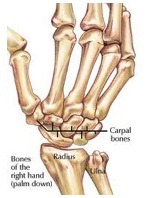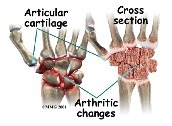The wrist is a complex joint involving the articulation between 8 small carpal bones, the 2 bones of the forearm (ulna and radius) and your 5 key hand bones (metacarpals). The wrist has multiple ligaments to aid stability around each of these boney articulations. The complex nature of these articulations is what enables us to have such flexibility and combined movement options of the wrist, but of course, this also means that this complex is prone to injury.
There are multiple tendons around this region involved in moving our wrist, fingers and thumb at differing joint levels. These tendons can become inflamed and painful with overuse use injuries or repetitive tasks – one example being DeQuirvain’s syndrome at the base of the thumb.
Our three main upper limb nerves (median, ulna and radial) run through the wrist complex under a thick ligamentous type structure called our retinaculum. As a result, these can also be a source of wrist pain or tingling symptoms in the fingers/hand. The most common being carpal tunnel syndrome – compression/irritation of the median nerve.
In addition, we have a wedge of triangular cartilage on the outside of the wrist, under the ulna (forearm bone) to aid our load bearing and wrist stability. This is called our TFCC (triangular fibrocartilage complex) – this too can become a source of pain or dysfunction in the wrist, leading to nonspecific pain around the outside of the wrist and hand and/or clicking. This can occur as a result of a traumatic incident or just gradual overuse.
The problem
- Acute injury or overuse syndromes can cause wrist pain.
- Acute injuries, such as a fall on an outstretched hand, can cause sprains, strains and even fractures.
- Any activity that involves repetitive wrist movements can cause inflammation of structures in and around the wrist.
- Common overuse injuries include DeQuervain’s Tenosynovitis and Carpal Tunnel Syndrome.
- The risk of developing an overuse injury increases if there is poor technique whilst performing repetitive tasks.
Interesting facts
- The wrist is a complex joint, comprised of 8 small carpal bones arranged in 2 rows, which lay between the bones in your forearm, and the bones in your hand.
- Ligaments connect the carpal bones to each other, to the forearm and to the bones of the hand.
- There are also many tendons responsible for flexing and extending the fingers and wrist, these may become injured at the wrist as well.
- Three major nerves are responsible for innervating your hand, the ulna, radial and median nerve, all of which cross the wrist.
- Finally, there is a disc known as the Triangular Fibrocartilage Complex that connects the ulna to the carpal rows/hand and provides a surface for the carpal bones to slide across during movement.
What you can expect/look out for
- Wrist pain varies, depending on what’s causing it. For example, osteoarthritis typically causes a dull pain, while tendonitis causes a sharp, stabbing pain, with a nerve impingement producing a sensation of pins and needles
Hints for self-management
- Rest
- Ice and anti-inflammatory medication if the area is swollen
- An over-the-counter wrist brace may help support the joint and reduce pain
- The treatment for wrist pain varies based on the source of the pain. Conservative treatment with physiotherapy and/or cortisone injections is usually attempted before surgical intervention is considered, especially with chronic pain conditions.
- Physiotherapy intervention will focus on stretching tight structures and strengthening weak structures.
- The movement pattern used to perform your usual activities should also be analyzed for any errors in technique that may be contributing to your wrist pain.
More information
- Use appropriate protective gear for sporting activities
- Pay attention to ergonomics. Use the ergonomic devices available for your task, take regular breaks, keep your wrists in a neutral position when you type and improve your posture, all can help to reduce your risk of developing an overuse injury.
At Sydney Physiotherapy Solutions our highly qualified physiotherapists specialise in the assessment, treatment and prevention of neuromusculoskeletal injuries.
Contact us today – 9252 5770



